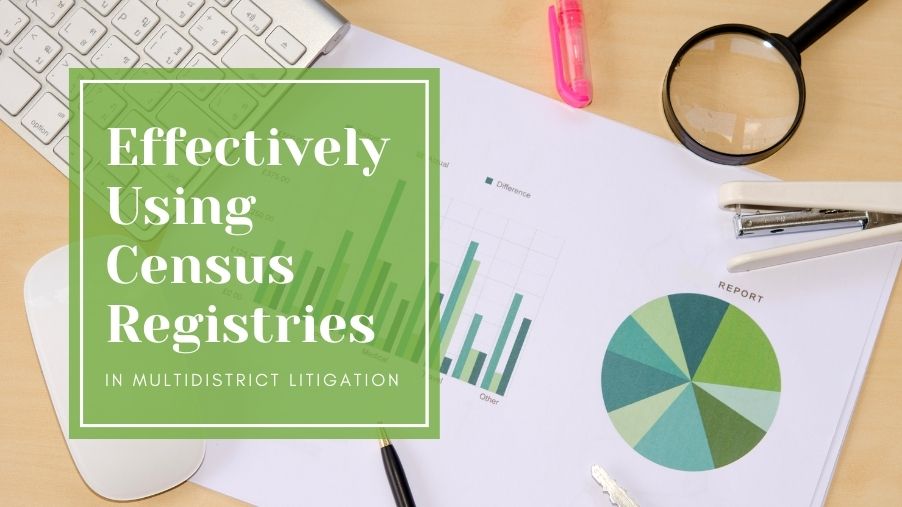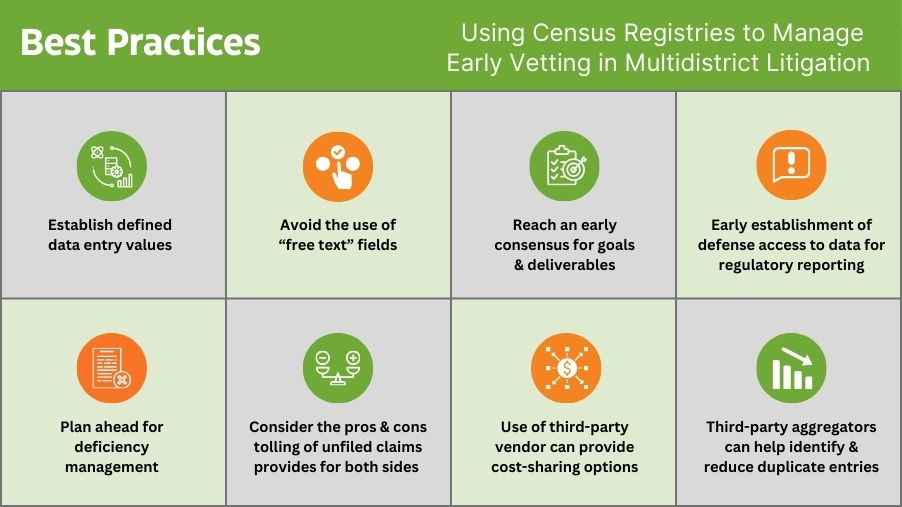
October 16, 2023
For years, there have been discussions and debates regarding best practices for the management of Multidistrict Litigation (MDL) and how to most efficiently and effectively approach the many complex issues that arise with the large number of claims and parties involved. LMI recently partnered with the Product Liability Advisory Council (PLAC), a nonprofit professional association of corporate product manufacturers and their legal counsel, to host a webinar exploring one such issue - the importance of early vetting of claims, including the effective use of census registries in MDLs.
Let’s review the webinar takeaways and what may be on the horizon for MDL management.
Federal Rules of Civil Procedure Draft Rule 16.1 and What it Means for Litigation Attorneys
Federal Rules of Civil Procedure (FRCP) Draft Rule 16.1 is intended to provide guidance to courts and parties regarding early case management in MDLs. The draft rule emphasizes the importance of early information exchange in legal proceedings, aiming to streamline the litigation process by encouraging parties to identify and address key issues as soon as possible. Such early information exchange can include processes to verify claims for merit.
The draft rule outlines that the transferee court should schedule an initial management conference to develop a management plan for orderly pretrial activity in MDL proceedings. Additionally, the rule encourages parties to submit a report to the transferee court prior to the initial MDL management conference addressing any matter designated by the court.
The U.S. Judiciary Conference’s Advisory Committee on Civil Rules will hold three hearings to hear public comment on the proposal. The first hearing was held on Monday, October 16, 2023, in Washington, D.C., in which the rule was criticized as ineffective with suggestions to establish a stricter claimant review process.
The deadline for public comment to the draft rule is February 16, 2024.
Census Registry Basics in Multidistrict Litigation
A census registry is an initial census questionnaire developed by parties to meet the specific allegations and requirements of a particular matter. The data from the registry can be used to provide visibility into the claimant/plaintiff inventory, including jurisdictional, allegation, and other trends. These insights enable early vetting of claims, initial case assessments and claim verification data.
In recent litigations, the key difference between an “MDL census” and an “MDL census registry” has primarily been driven by unfiled claimants as opposed to filed plaintiffs. In census registries, there is typically a process used to gather information on the inventory of unfiled claims in exchange for some form of benefit, such as tolling of the statute of limitations for a specified period.
| MDL Census | MDL Census Registry | |
|---|---|---|
| Process | Tool implemented by judges and special masters to gather early and high-level data on the inventory of filed cases. | Technology-supported processes that allow unfiled claimants to "register" their claims prior to filing suit. Frequently managed by a third-party vendor or claims administrator. |
| Purpose | To gauge the extent of use/exposure and alleged injuries among plaintiffs and to appoint leadership positions. | To gain insight into case inventory and potentially identify meritless or unsupported claims. Census registries may be for unfiled claimants only, or may include both filed and unfiled claim information. |
| MDLs Using Census Registries |
|---|
| In re 3M Combat Arms Earplug Prod. Liab. Litig., MDL No. 2885 PTO #18 - Order Governing Initial Census Requirements for Filed Cases (10/22/2019) |
| In re Juul Labs, Inc. Marketing, Sales Practices & Prod. Liab. Litig., MDL No. 2913 CMO #1 - Initial Census (10/25/2019) |
| In re Zantac (Ranitidine) Prod. Liab. Litig., MDL No. 2924 PTO #15 - Order on Procedures for Implementing Census (4/02/2020) |
| In re Philips Recalled CPAP, Bi-Level Pap, and Mechanical Ventilator Prod. Litig., MDL No. 3014 PTO #25 - Approving Census Registry Program (9/14/2022) |
Census Registry vs. Plaintiff Fact Sheet (PFS)
Plaintiff Fact Sheets are typically longer in comparison to census registries. Many factors can contribute to the length of a PFS, such as the size and complexity of the case and the type/range of alleged injury(ies).
PFSs are a significant investment in both time and cost. Since PFSs are longer in nature, they require a much longer period of negotiation between parties, as well as time invested into setting up a technology tool that is aimed at discovery and will meet all the needs of all parties.
A census registry is a shorter, uniform set of questions for all claimants to get a high-level view of the claimant inventory and assess if there are claims that do not meet specific exposure/usage criteria and should therefore be removed from the registry (and, presumably, prevented from future case filing).
| Plaintiff Fact Sheet | Census Registry |
|---|---|
|
|
Census registries serve as an expedited process to assess the claimant pool prior to filing suits. Data points to consider when determining if a census registry is appropriate for a litigation are:
- Number of potential claimants
- Number of filed plaintiffs
- Matter type
- Number of defendants
- Allegations/injuries
Best Practices When Using a Census Registry to Manage Early Vetting in MDLs
While the use of census forms and census registries is still relatively new, there is a great deal to be learned from the cases that have adopted this concept, including ways to continue fine-tuning the process for future litigations. The below list represents some of the lessons learned from LMI’s specific experience with census registries.

- Data Normalization & Reporting
Ensuring proper data normalization (i.e., facilitating a cohesive, uniform set of questions and manner of data entry) allows for seamless data importing and processing. This leads to more accurate and comprehensive data analytics that can be sorted and filtered to best meet the needs of the parties, judges, and/or special masters.
- Challenges of “Free Text” Fields
Free text fields do not allow for accurate analytics and reporting due to the endless opportunity for errors and response ambiguity. For example: A free text field for plaintiffs to provide state of residence may receive varying responses, such as OH or Ohio. The inadvertent inclusion of leading or trailing spaces can also complicate resulting analytics.
- Defendant Roles & Obligations
In cases with multiple defendants and defendant types (such as chemical manufacturers, as well as distributors, and other supply chain participants), it is important to come to a consensus as early as possible regarding the goals of the census registry and the expectations for the resulting deliverables and analytics.
- Regulatory/Safety Reporting
Unfiled claimants that are under tolling agreements may impact requirements for regulatory or product safety reporting. It can be very important to determine early on when and to what extent defendants will have access to aggregate versus specific claimant data, to best plan for and meet individual regulatory obligations.
- Addressing Deficiencies
In any information-gathering tool (PFS, census registry or other discovery medium), there will always be deficiencies, no matter how simple the form. A third-party vendor can provide ways to reduce the number and type of deficiencies and tools to both prevent and quickly identify such deficiencies.
- Tolling of Unfiled Claims
The tolling of unfiled claims can have benefits to both plaintiffs and defendants, including the ability to gather information earlier in the litigation than may be available through more traditional discovery tools (such as a PFS). However, there are also concerns on the impact of potentially encouraging a higher volume of potential litigants, due to the lower thresholds required for census registries versus more thorough PFSs. Parties should fully consider the pros and cons of gathering information on unfiled claimants, the impact of tolling, and what tools or options may be utilized to mitigate risk and best manage early discovery – based the unique needs of the specific matter.
- Cost Sharing Considerations
Both parties will need to assess the cost involved with implementing a census registry. The anticipated volume of claimants/plaintiffs is a key factor in doing a cost-benefit analysis maximizing the value of the census registry. Utilizing an experienced third-party vendor can provide the option of cost sharing.
- Role of Third-Party Aggregators
Third-party aggregators may assist plaintiff firms with identifying claimants and performing initial case intake. The use of aggregators can sometimes impact the occurrence and/or frequency of duplicates and dual representations. For matters that may involve third-party aggregators, or otherwise anticipate an increased potential for duplicates/dual representations, effective census registry platforms can help to identify and reduce the occurrence of duplicated claimant entries.
How Can LMI Assist with Census Registries in Multidistrict Litigation
LMI has extensive experience in personal injury and product liability litigation, managing complex data and all medical aspects of discovery. Our team of legal professionals and data analysts can work with all parties to identify and develop a census questionnaire to meet the specific requirements of the case. Data is entered into our proprietary, secure online census platform from which analytics can be generated from the responses, providing real-time insight into the trends associated with claimant inventory.
Have a case to discuss? Contact us today for a free consultation.